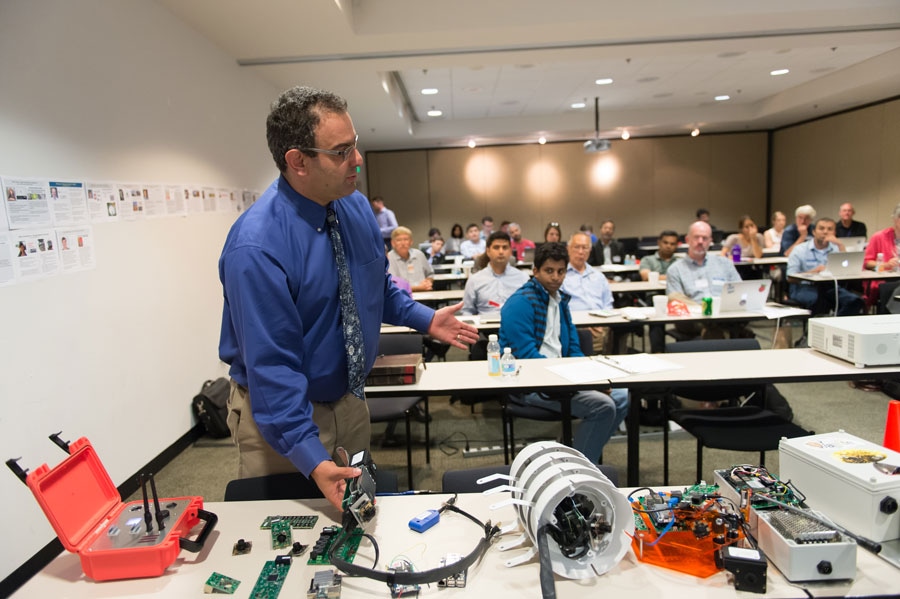Feb 21 2017
Less than two years since its release, interest and demand for Waggle, a wireless environmental sensing platform created at the Department of Energy’s (DOE) Argonne National Laboratory, is flourishing among research groups, industry and government entities, its creators say.
 David Lary, an atmospheric scientist at the University of Texas-Dallas, discusses air particulate sensors that are being integrated in the Argonne-developed Waggle platform to measure and monitor air quality in Chattanooga, Tennessee. (Image by Wes Agresta/Argonne National Laboratory.)
David Lary, an atmospheric scientist at the University of Texas-Dallas, discusses air particulate sensors that are being integrated in the Argonne-developed Waggle platform to measure and monitor air quality in Chattanooga, Tennessee. (Image by Wes Agresta/Argonne National Laboratory.)
Waggle is the first platform to combine environmental lightweight sensors with computer hardware and software for “edge computing” within a portable node, or device. Edge computing allows Waggle nodes to process image and audio data directly inside the sensor node by using new technologies in machine learning.
“Most people know Waggle in connection to Chicago’s Array of Things, which is an urban experiment, but there are many other settings in which Waggle is being used.” – Pete Beckman
Each node collects and transmits environmental data wirelessly via the cloud. By distributing multiple nodes across sites, researchers can access environmental data in near real time, helping improve the efficiency of research and discovery.
Top experts in environmental sensing explored existing and potential applications for Waggle and other sensing technologies during a two-day workshop held at Argonne in mid-September. Among the more than 50 attendees were representatives from NASA, the EPA, Honeywell, Bosch, the University of Texas-Dallas and the City of Portland, among others.
“Most people know Waggle in connection to Chicago’s Array of Things, which is an urban experiment, but there are many other settings in which Waggle is being used,” said Pete Beckman, leader of the Waggle project at Argonne.
From researching deforestation in the Amazon to improving air quality for manned space missions, attendees revealed unique ways to apply sensing technology to improve our understanding of Earth and human health.
For example, one workshop attendee, University of Texas-Dallas atmospheric scientist David Lary, uses Waggle to study the relationship between asthma and pollen in Chattanooga, Tennessee, a city that consistently ranks high in childhood asthma incidence within the U.S. His project, known as the Geolocated Allergen Sensing Platform, combines Waggle with a sensor that detects pollen and other air particulates.
“What we hope this project will allow us to do is make real-time measurements of the air particulates and pollen present in any given location, and with that we can provide an alert to people so they can make more conscious decisions about their health,” Lary said.
The powerful edge computing capability of Waggle enables the nodes to process image and audio data and to make use of the latest machine learning techniques. Waggle nodes can be programmed to identify birds, cars, bicycles and types of clouds, giving scientists holistic data about a node’s surroundings as well as environmental data. This capability is quite unique, and will be the future of intelligent sensing platforms, Beckman said.
Waggle also uses lightweight sensors, a relatively cheap category of sensor already found in everyday items, such as household sensors like carbon monoxide and ozone detectors, as well as the temperature and pressure detectors found in phones, gaming systems and wearable devices.
A lightweight sensor can range from tens to hundreds of dollars, while the alternative “reference sensor,” a more precise but also heavier and more expensive sensor, can cost anywhere from $20,000 to $100,000.
“The problem with the reference sensors is that people can only afford one, two, maybe three of them, but what they want is to buy is tens or hundreds,” Beckman said.
As lightweight sensors and the Waggle system are applied more widely, Beckman says that he and other researchers still need to work to improve system performance and software design for data collection and analysis and visualization, all while aiming to maintain a relatively low cost.
Two other workshop attendees – Cristina Negri, an Argonne agronomist and environmental engineer, and Bill Miller, a professor of chemical and biological engineering at Northwestern University – also use Waggle in non-urban sensing projects.
In one of their projects, done in partnership with the Nature Conservancy and Northeastern Illinois University, Miller and Negri are using Waggle to monitor water flow across a prairie site in the Calumet region. The researchers are focused on monitoring the levels and movements of water to better understand the prairie ecosystem and examine how water movement within the prairie may be affecting surrounding residential communities.
“Aside from being great reservoirs for biodiversity, green areas like this help with problems of flooding and with maintaining clean air,” Negri said. “So there are a lot of benefits from keeping these green places as healthy as possible, both locally and globally.”
The Nature Conservancy prairie project and the Geolocated Allergen Sensing Platform Project are both funded by the National Science Foundation. The Waggle project is supported by Argonne’s Laboratory-Directed Research and Development program.
Source: https://www.anl.gov/